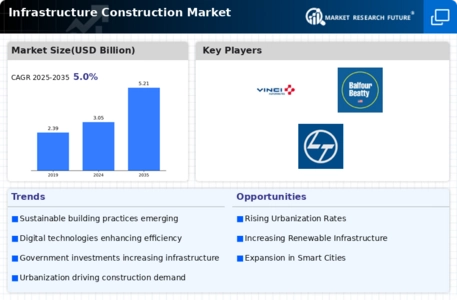By region, the study provides market insights into North America, Europe, Asia-Pacific, and Rest of the World. The anticipated expansion of the Infrastructure Construction market in North America can be attributed to several key factors. Roadway construction stands as a primary component of transportation infrastructure, with public transit utilizing roadways contributing significantly to the economy. Mexico has invested approximately USD 4.6 billion in 16 projects, encompassing the construction of road infrastructure, highway projects, interchanges, and more.
Notably, in Mexico, the commencement of projects like the Cuapiaxtla-Cuacnopalan highway (valued at USD 209 million) and the Altar-Sásabe highway (valued at USD 230 million) was scheduled for the first quarter of 2021.
Further, the major countries studied in the market report are the US, Canada, Germany, France, the UK, Italy, Spain, China, Japan, India, Australia, South Korea, and Brazil. In October 2023, STRABAG invested in safe, sustainable and affordable energy storage solutions development and production. STRABAG intends to accelerate specific large-scale energy storage projects with construction & infrastructure support by partnering with storage producer CMBlu Energy.
The combination of best-in-class storage technology, on the one hand, and construction & infrastructure know-how, on the other hand, creates real opportunities for industrial companies, municipal utilities as well and grid operators who will be able to build large electricity warehouses equipped with Organic Solidflow batteries in years ahead.
Figure 2: INFRASTRUCTURE CONSTRUCTION MARKET SHARE BY REGION 2022 (USD Billion) Source: Secondary Research, Primary Research, Market Research Future Database and Analyst Review
Source: Secondary Research, Primary Research, Market Research Future Database and Analyst Review
Europe's Infrastructure Construction Market accounts for the second-largest market share as in 2018, the total number of newly initiated dwellings, permitted but not necessarily completed, reached 27,600, marking a 3.6% year-on-year growth, the highest figure since 2009. Additionally, there was a slight increase of 0.5% year-on-year in the number of dwellings initiated in multi-family buildings, totaling 7,300, which, although the highest since 2009, remains nearly 50% below the pre-crisis level of 2008. The construction output in 2018 experienced a significant 8.4% year-on-year increase in real terms, the highest rate since 2004.
This growth was predominantly driven by building construction, which expanded at an 8.6% pace, contributing 6.3 percentage points. Civil engineering construction also demonstrated a robust performance with an 8.0% year-on-year increase. Further, the German Infrastructure Construction Market held the largest market share, and the UK Infrastructure Construction Market was the fastest-growing market in the European region
The Asia-Pacific Infrastructure Construction Market is expected to grow at the fastest CAGR from 2023 to 2032. Infrastructure plays a crucial role in fostering the growth and competitiveness of the Indian economy within the industrial sector, contributing to overall economic advancement. To expedite infrastructure projects, the current administration has committed to reducing delays, simplifying processes, and enhancing transparency. The government unveiled a comprehensive plan under the National Infrastructure Pipeline (NIP) for the fiscal years 2019-25, encompassing infrastructure projects valued at INR 111 lakh crore (USD 1.5 trillion).
Initially allocated for 6,835 projects, the number increased to 7,400 by the end of 2021. The majority of these projects focus on areas such as roads, housing, urban development, railways, renewable energy, conventional power, and irrigation. Moreover, China’s Infrastructure Construction Market held the largest market share, and the Indian Infrastructure Construction Market was the fastest-growing market in the Asia-Pacific region.



 Source: Secondary Research, Primary Research, Market Research Future Database and Analyst Review
Source: Secondary Research, Primary Research, Market Research Future Database and Analyst Review










Leave a Comment